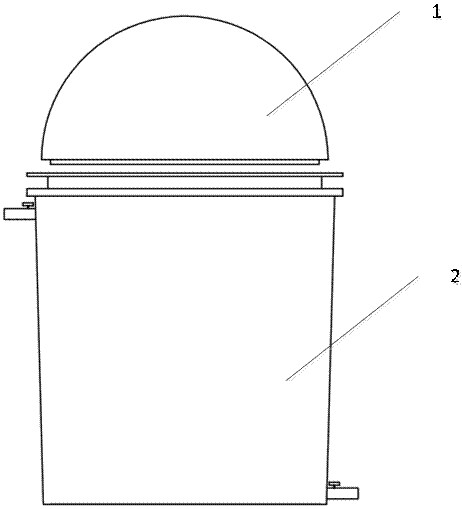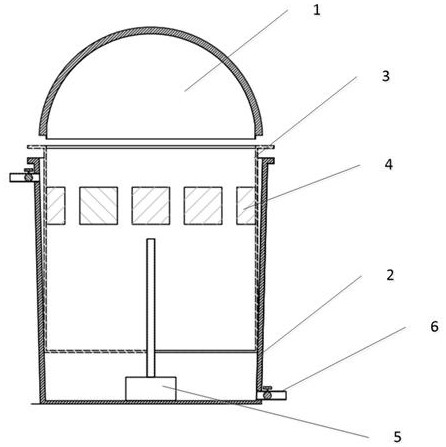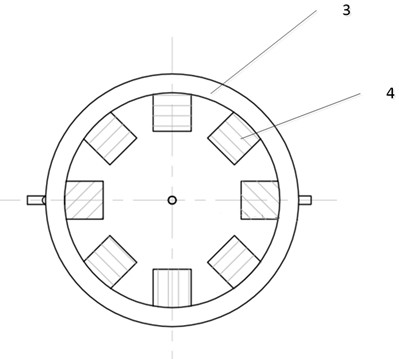A device for metamorphosis of tortoise-foot Venus larvae
A technology for Venus larvae and attachment metamorphosis, which is applied in climate change adaptation, application, fish farming, etc., and can solve the problems of special ecological requirements and difficult attachment and metamorphosis of Venus larvae.
- Summary
- Abstract
- Description
- Claims
- Application Information
AI Technical Summary
Problems solved by technology
Method used
Image
Examples
example 1
[0021] Example 1: On June 20, 2019, the Venus larva attachment metamorphosis experiment was carried out in the breeding room of the Southern Ocean Research Institute of Fujian Normal University. Put this device and the breeding tank in the same environment, add the same kind of attachment base, and add 100L of filtered seawater to each, where the water temperature is 25°C, the salinity is 29, and the pH is 8.0. Cultivate and collect Venus larvae, put 2000 Venus larvae into the barrel, adjust the respective switches, cover the barrel lid and start the experiment.
[0022] After 7 days in this device, an average of 729 Venus larvae completed the attachment metamorphosis, and the attachment metamorphosis rate reached 36.5%, while the attachment metamorphosis rate in the breeding tank was only 3.2%.
[0023] Table 1 Comparison of attachment metamorphosis and growth of tortoise-foot Venus larvae
[0024]
[0025] Description: The counting method adopts brush brushing and micros...
example 2
[0026] Example 2: On August 29, 2019, the Venus larva attachment metamorphosis experiment was carried out in the breeding room of the Southern Ocean Research Institute of Fujian Normal University. Put this device and the breeding tank in the same environment, add the same kind of attachment base, and add 100L of filtered seawater to each, where the water temperature is 26°C, the salinity is 29.3, and the pH is 8.0. Cultivate and collect Venus larvae, put 5,000 Venus larvae into the barrel, adjust the respective switches, cover the top barrel lid and start the experiment.
[0027] After 7 days in this device, an average of 1616 Venus larvae completed metamorphosis, and the rate of metamorphosis reached 37.3%, while the rate of metamorphosis in the culture tank was only 4.3%.
[0028] Table 2 Comparison of attachment metamorphosis and growth of tortoise-foot Venus larvae
[0029]
[0030] Description: The counting method adopts brush brushing and microscopic counting.
example 3
[0031] Example 3: On October 20, 2019, the Venus larva attachment metamorphosis experiment was carried out in the breeding room of the Southern Ocean Research Institute of Fujian Normal University. Put this device and the breeding tank in the same environment, add the same kind of attachment base, and add 100L of filtered seawater to each, where the water temperature is 24°C, the salinity is 29.0, and the pH is 7.9. Cultivate and collect Venus larvae, put 15,000 Venus larvae into the barrel, adjust the respective switches, cover the top barrel lid and start the experiment.
[0032]After 7 days in this device, an average of 5576 Venus larvae completed metamorphosis, and the rate of metamorphosis reached 40.5%, while the rate of metamorphosis in the culture tank was only 2.5%.
[0033] Table 3 Comparison of attachment metamorphosis and growth of tortoise-foot Venus larvae
[0034]
[0035] Description: The counting method adopts brush brushing and microscopic counting.
[0...
PUM
 Login to view more
Login to view more Abstract
Description
Claims
Application Information
 Login to view more
Login to view more - R&D Engineer
- R&D Manager
- IP Professional
- Industry Leading Data Capabilities
- Powerful AI technology
- Patent DNA Extraction
Browse by: Latest US Patents, China's latest patents, Technical Efficacy Thesaurus, Application Domain, Technology Topic.
© 2024 PatSnap. All rights reserved.Legal|Privacy policy|Modern Slavery Act Transparency Statement|Sitemap



